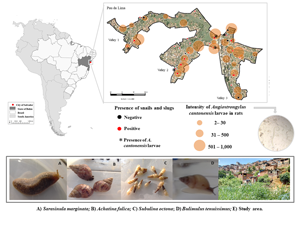Article contents
Angiostrongylus cantonensis in urban populations of terrestrial gastropods and rats in an impoverished region of Brazil
Published online by Cambridge University Press: 12 April 2021
Abstract

The nematode Angiostrongylus cantonensis is the most common cause of neuroangiostrongyliasis (manifested as eosinophilic meningitis) in humans. Gastropod molluscs are used as intermediate hosts and rats of various species are definitive hosts of this parasite. In this study, we identified several environmental factors associated with the presence and abundance of terrestrial gastropods in an impoverished urban region in Brazil. We also found that body condition, age and presence of co-infection with other parasite species in urban Rattus norvegicus, as well as environmental factors were associated with the probability and intensity of A. cantonensis infection. The study area was also found to have a moderate prevalence of the nematode in rodents (33% of 168 individuals). Eight species of molluscs (577 individuals) were identified, four of which were positive for A. cantonensis. Our study indicates that the environmental conditions of poor urban areas (presence of running and standing water, sewage, humidity and accumulated rain and accumulation of construction materials) influenced both the distribution and abundance of terrestrial gastropods, as well as infected rats, contributing to the maintenance of the A. cantonensis transmission cycle in the area. Besides neuroangiostrongyliasis, the presence of these hosts may also contribute to susceptibility to other zoonoses.
Keywords
- Type
- Research Article
- Information
- Copyright
- Copyright © The Author(s), 2021. Published by Cambridge University Press
Footnotes
These authors contributed equally to this work.
References
- 7
- Cited by





